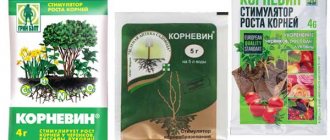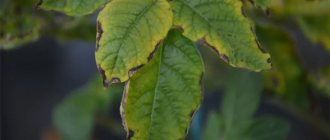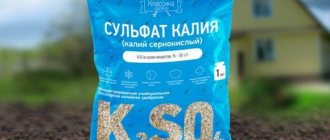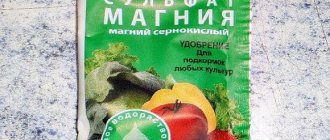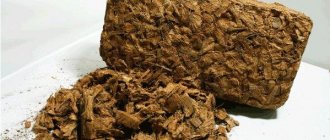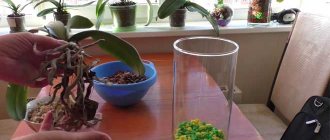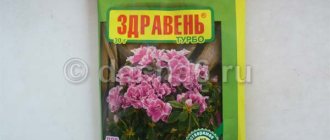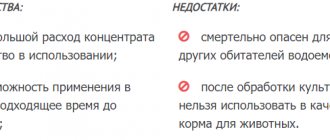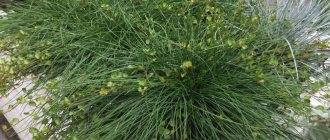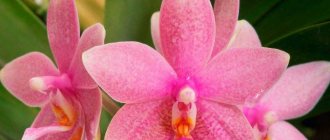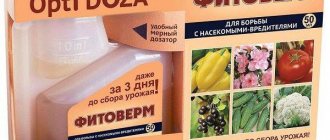Author: Elena N. https://floristics.info/ru/index.php?option=com_contact&view=contact&id=19 Category: Bioregulators Published: July 29, 2014Last edits: February 20, 2020
Anyone who has tried to germinate seeds, replant a plant and root cuttings knows that achieving a 100% result is very difficult, and sometimes impossible, since not all seeds germinate, not all cuttings are viable and not all transplanted plants take root in a new place. Medicines called growth stimulants help minimize risks. One of the most reliable drugs in this group is Kornevin. Our story will be about the properties of this growth stimulator and how to use it.
Kornevin's action
Kornevin contains indolylbutyric acid (IBA), which is the main active ingredient: when it gets into the soil, IBA is converted into the hormone heteroauxin, which stimulates the growth of callus and roots due to irritation of the integumentary tissues of the plant. Plants can be treated with Kornevin no more than twice: before planting and after planting.
Cuttings treated by Kornevin not only take root more easily, but are also much less likely to become infected with rot. The root system under the influence of this biostimulator develops faster, and the plant itself becomes more resistant to excess or lack of moisture in the soil, as well as to sudden changes in temperature.
- Reviews and instructions for using Prestige on potatoes
An analogue of Kornevin to one degree or another is the drug Heteroauxin.
Advantages of Kornevin:
- the drug can be used for almost all crops;
- the development of cuttings after using Kornevin is significantly accelerated;
- in all plants the root system develops better and faster;
- seedlings adapt and take root more easily;
- the use of the drug can stop fruit falling from the tree;
- plants become more resistant to unfavorable environmental factors;
- Kornevin is compatible with many drugs;
- The drug has a very affordable price.
Kornevin also has disadvantages:
- in case of an overdose of the drug, plants can get burned or rot;
- an aqueous solution of the drug sometimes gives a weak effect, and sometimes is not effective at all.
Advantages and disadvantages of the drug
Any drug has both positive and negative sides, and Kornevin for root growth is no exception.
Advantages
The benefits of the drug for root growth include:
- the ability to increase plant immunity to diseases;
- wide range of applications;
- long-term impact on roots;
- stimulation of the growth of the root system of plants and its strengthening.
According to surveys of summer residents, the colors of plants become brighter after using Kornevin. Some plants that have medicinal functions enhance properties. Kornevin is available for sale in different versions. But most often you can find Kornevin in the form of a light cream powder. The drug contains few substances. However, if the product gets on a person’s mucous membranes or eyes, a burn may occur. Therefore, you must carefully use Kornevin and remember that side effects may occur if you violate the technology.
Flaws
Despite the large list of positive aspects, Kornevin also has its disadvantages:
- toxic to humans and animals (class 3 toxicity), causes burns;
- the need to use protective equipment when working with the drug;
- rapid loss of properties of the prepared composition;
- negative consequences for plants with an overdose of the drug.
Attention: the need to use the drug Kornevin is aimed at stimulating the growth of the root system. The solution is not an alternative to fertilizers.
Instructions for use of Kornevin
Kornevin – dry application
- Kornevin is produced in the form of a fine powder in the shade of baked milk in bags of different capacities: 4, 5, 10, 50 g. It is used in dry form and in solution.
- Before planting plants, their roots are dusted with Kornevin. Dry Kornevin powder can be mixed in equal parts with charcoal powder or in a 10:1 ratio with a fungicide (for example, the biological product Fitosporin-M). This mixture will not only help the plant take root faster, but will also strengthen its resistance to fungal diseases.
- The cuttings can be powdered with a root former, or you can simply dip them into a container of powder and then shake off the excess. Cuttings should be dipped no deeper than 2 centimeters, and leaf cuttings should be no deeper than 1 cm. After treatment with Kornevin, the cuttings are immersed in water or planted in a prepared substrate for rooting.
Application of Kornevin solution
Kornevin's solution is used for watering plants, as well as for treating their bulbs, seeds and tubers. The solution is 0.1%, that is, 1 g of Kornevin is dissolved in 1 liter of water. Seeds and bulbs are soaked in this solution for 16-20 hours. Only a freshly prepared root former solution is effective.
Consumption of Kornevin solution:
- tree seedlings (both fruit and ornamental) - 2-3 liters per 1 tree;
- shrub seedlings – 0.25-0.3 l per 1 bush;
- seedlings of fruit and vegetable crops – 50-60 ml per 1 seedling;
- flower seedlings - 30-40 ml per 1 seedling.
Kornevin analogues - how can you replace the stimulant?
When Kornevin is not available - what to do? It doesn’t matter, you can replace it with other drugs with similar effects.
How to prepare a natural ROOTS GROWTH STIMULANT. KORNEVIN with your own hands. Various recipes - video
Analogues of Kornevin include:
- Energen;
- Athlete;
- Kristalin;
- Zircon;
- Heteroauxin;
- Immunocytofin.
The effect of the drug is influenced by the condition of the soil, its nutritional value, and looseness. And, of course, environmental conditions are important. For example, in greenhouse conditions, Kornevin is combined with fungicides. The reason for this is that under the influence of humidity, spores have a higher reproduction rate.
Precautionary measures
When working with the drug, you need to wear a plastic apron, latex gloves, a gauze bandage or a respirator, and glasses. To prepare the working solution, do not use containers that are used for eating or preparing food or containing drinking water. During the procedure you should not drink, eat or smoke. After finishing work, you must take a shower and put on clean clothes.
- A reliable and simple remedy for grape oidium - colloidal sulfur
Empty packaging should be burned or thrown away with household waste.
Composition, action and dosage
In addition to IBA (0.5% of the dry weight of the substance, or 5 g per 1 kg of commercial powder), the root composition includes macro- and microelements that promote root formation: potassium, phosphorus, manganese and molybdenum. Kornevin is diluted simply: the number of grams in a bag is the same as regular tap water. It is also possible to pollinate the roots with a dry preparation, see below. The action of the root is based on the formation of an influx over the cut/fracture - callus; Kornevin as a phytohormone is primarily a stool former. Dormant buds awakened in the callus send out roots much more intensively than on other parts of the cutting, which is clearly visible in Fig.
Callus with young roots on a cutting
However, it is necessary to use root with caution. If the mother plant itself is well cut (the callus before root formation is small or not noticeable), the root will only delay rooting. Left on the trail. rice. it is clear that bean cuttings without IMC and root root take root and develop better. In this case, the rooting of strong cuttings from a strong healthy plant should be accelerated (if required) with heteroauxin, and the formation of roots on weak ones should be stimulated with epin.
The effect of indolylbutyric acid and root on plants with varying degrees of susceptibility to them
Note: in general, we do not particularly recommend Kornevin for cuttings of herbaceous plants; in this case, its purpose is somewhat different, see below.
Cuttings of moderately or weakly rooted plants (roses, hibiscus, indoor citrus fruits and grapes, indoor pomegranate) together with rootstock usually require the use of additional preparations; most often - specific to a given species. For example, rose cuttings root much better if root is used in combination with zircon, on the right in Fig. In any case, 3-7 days after planting a rooted cutting, you need to give it phosphorus-potassium fertilizer so that the rapidly growing roots “suck in” the callus, otherwise the seemingly well-established cutting may rot. Don’t rely on rich soil here; you need quickly absorbed mineral fertilizers.
About cuttings of conifers
Conifers are the most difficult to take cuttings. For them, phytohormones alone are not enough; a special cutting technique is needed. For example, how to propagate blue spruce and juniper with cuttings at home, see video:
Video: about propagation of blue spruce and juniper by cuttings
Cuttings of conifers make sense not only as saving costs on planting material. The species on the list were chosen because, grown from cuttings, these conifers can grow in pots in an apartment. Don't you feel sorry for the Christmas trees that are cut down en masse on New Year's Eve? And so it will be your own, alive. Juniper not only exudes a large amount of air-healthy phytoncides, but also produces “berries” (cones in a fleshy shell), which are widely used in pharmacopoeia, for enhancing drinks, etc.
A note on an unhealthy topic: juniper “berries” are excellent at absorbing fusel oils, while at the same time flavoring the alcohol.
First aid
The recommendations below are intended only for providing FIRST aid, after which you should immediately consult a doctor and follow his instructions! DO NOT SELF-medicate!
- Although the drug is not very dangerous, getting it into the body or on the skin can have unpleasant consequences.
- If the drug gets into the digestive system, you must immediately drink several glasses of water with activated carbon at the rate of 1 tablet per 10 kg of body weight and immediately call a doctor!
- If Kornevin gets into your eyes, rinse them in the open position with plenty of running water.
- If the drug gets on the skin, the contact area should be washed with plenty of cold running water.
How and how long is Kornevin stored?
The prepared solution is applied immediately. Cannot be stored. The container in which the solution was contained must be thoroughly rinsed and packaged so that children or pets do not have access to it.
As a rule, each package of the Kornevin stimulant has an expiration date marked. However, its effect applies exclusively to the packaged material, in other words, until the box is opened. When the mixture has already been opened, it is necessary to place it in a cool place, away from light. The box must be tightly closed.
The room where the opened box is stored must be dry. When all requirements are met, the powder can be stored for up to 6 months.
When the powder begins to harden or a drop of water gets on it, it should be disposed of environmentally.
Reviews
Maria: Kornevin is a strong stimulant that strengthens plant resistance to all sorts of adverse factors. I use it to support indoor plants weakened by disease or transplantation, to germinate seeds, and also to support rooting cuttings.
Peter: I use Kornevin when growing seedlings and when transplanting seedlings into the garden. The seedlings are strong and viable, very rarely get sick and can easily tolerate picking and transplanting.
Anastasia: I am an avid summer resident, I really love all kinds of experiments. The first time I used Kornevin to strengthen pruned seedlings: I simply added root former powder to the soil. The seedlings turned out to be surprisingly strong, with a developed root system. I watered a weak sapling of bush St. John's wort with Kornevin's solution, and it began to come to life right before our eyes.
Official website and manufacturer's recommendations: https://www.grepharm.ru/products/159/404/
How to root a rose from a bouquet using root
Sometimes green buds form on the stems of roses from a bouquet in place of torn leaves. If you like the variety, you should try rooting the cuttings. To do this, the stem is cut off at the bottom and top, leaving 3 healthy swollen buds.
The lower part of the stem from the cut to the lowest bud is scratched with a sharp knife to make it easier for the roots to germinate. Then this place, including the cut and the lower bud, is dipped in the root, and after a few minutes the excess is shaken off and the cutting is planted in a planting container. The top two buds should remain on the surface. It is advisable to use special soil for roses.
Cover the top of the container with polyethylene or cover it with a transparent plastic glass and place it in a warm, bright place. From time to time, the shelter is removed for ventilation and, if necessary, the soil is moistened.
To root roses, experts advise using rootin together with zircon.
If there are still living cuttings from the bouquet, you can try rooting them in an aqueous solution of the drug. Planting material is prepared in the same way as for dry rooting. Only the lower bud of the cutting should remain in the water.
Do-it-yourself Kornevin substitutes
Before the advent of synthesized stimulants, plant growers often used homemade preparations that had a similar effect. They can be prepared today. The following formulations are suitable to stimulate root growth:
| Compound | Preparation | Application |
| Honey water | Dissolve 1 teaspoon of honey in 1 liter of warm water. The solution is cooled to room temperature. | Soak cuttings or plant roots for 10 hours. |
| Yeast mash | Dissolve 1 teaspoon of dry yeast and 1 teaspoon of honey in 1 liter of warm water. The solution is placed in a warm place. After signs of fermentation appear, the preparation is ready for use (see → use of yeast as fertilizer) | Soak cuttings or roots for 20 hours. |
These home remedies give a good effect, although it is noticeably lower than the effect of Kornevin. Their main advantage is that there is no risk of overdose.
Application for seedlings
Instructions for using root for seedlings include keeping the seeds in an aqueous solution for two hours. Crops that do not tolerate root damage well are watered with a stimulant during picking and two weeks after it. In order not to harm the sprouts, you need to know how to properly dilute the root for watering the seedlings. The working solution is prepared at the rate of 1 g of the drug per 1 liter of water. No more than 60 ml of liquid product is needed per plant. An overdose causes inhibition of seedling growth, so the seedlings are watered, carefully measuring the amount for each bush.
When transplanting grown seedlings into the ground, you should focus on the weather. On sunny and warm days it is not advisable to use the drug, since additional stimulation of root formation will stop the growth of the above-ground part and slow down the onset of fruiting. Favorable weather conditions themselves contribute to the development of the root system and further growth of the plant. More benefits will come from using the root for seedlings in a long, cold spring, when the earth is slightly warmed by the sun. At such a time, sprouts spend a lot of energy overcoming unfavorable conditions and transplanting into the soil turns out to be painful. To help young plants take root and maintain strength, a biostimulator is used. The powder solution is prepared according to the standard procedure described on the packaging.
Each bush is watered individually, at the root, so as not to cause rapid growth of weeds.
Also, the roots of the seedlings are kept in the working solution for several hours immediately before planting in the ground. If the seedlings are well rooted and actively growing, no more roots are used.
Rules for handling root
The drug belongs to hazard class 3, and you need to work with it with gloves, and it is better not to throw away the used packaging, but to burn it. The stimulant manufacturer prescribes the following handling precautions:
- the drug is not diluted in food containers;
- while working, you must not eat, smoke or drink;
- If you get it on your hands, wash them immediately with soap;
- in case of accidental ingestion of even microscopic doses, you should drink a large amount of water, induce vomiting and take activated charcoal;
- The drug is stored in places inaccessible to children.
All components of the root are not phytotoxic and are not carcinogenic, but the recommendations should not be neglected.
Using root crops allows you not only to obtain healthy, strong plants with a powerful root system, but also to achieve the rooting of the most unusual and exotic crops in your area. With its help, it is also easier to learn how to graft different varieties and obtain strong, viable scions.
